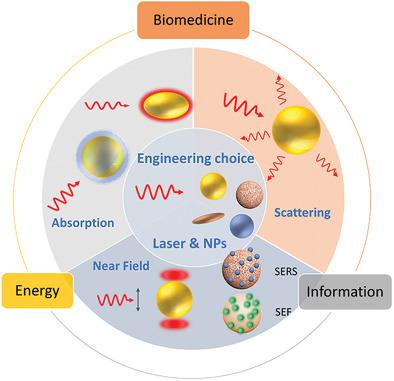当前位置:
X-MOL 学术
›
Adv. Funct. Mater.
›
论文详情
Our official English website, www.x-mol.net, welcomes your
feedback! (Note: you will need to create a separate account there.)
Optical Properties and Applications of Plasmonic‐Metal Nanoparticles
Advanced Functional Materials ( IF 18.5 ) Pub Date : 2020-09-16 , DOI: 10.1002/adfm.202005400 Lu Wang 1 , Morteza Hasanzadeh Kafshgari 1 , Michel Meunier 1
Advanced Functional Materials ( IF 18.5 ) Pub Date : 2020-09-16 , DOI: 10.1002/adfm.202005400 Lu Wang 1 , Morteza Hasanzadeh Kafshgari 1 , Michel Meunier 1
Affiliation

|
Noble metal nanoparticles due to their unique optical properties arising from their interactions with an incident light have been intensively employed in a broad range of applications. This review comprehensively describes fundamentals behind plasmonics, used to develop applications in the fields of biomedical, energy, and information technologies. Basic concepts (electromagnetic interaction and permittivity of metals) are discussed through Mie theory presented as the main model for interpreting phenomena of optical absorption and scattering. The effects of near‐field enhancement, shape, composition, and surrounding medium of nanoparticles on optical properties are described in detail. The review explores and identifies the potential of plasmonic nanoparticles based on their optical properties (e.g., light absorption, scattering, and field enhancement) for developing different applications (biomedical, energy and information technologies). Due to a significant impact of plasmonic nanoparticles on medicine and healthcare products and technologies, the review initially focuses on biomedical applications extensively benefited from optical features of these nanoparticles. Advantages of the optical properties outstandingly implemented are also briefly discussed in other applications, including energy and information technologies. This review concisely summarizes the explored areas based on plasmonic properties, compares advantages of plasmonic nanoparticles over other types of nanomaterials and highlights challenges.
中文翻译:

等离子体金属纳米粒子的光学性质及其应用
贵金属纳米颗粒由于其与入射光的相互作用而产生的独特光学特性,已在广泛的应用领域中得到广泛使用。这篇综述全面地描述了等离子技术背后的基础知识,这些技术用于开发生物医学,能源和信息技术领域的应用。通过Mie理论讨论了基本概念(金属的电磁相互作用和介电常数),Mie理论是解释光吸收和散射现象的主要模型。详细描述了纳米粒子的近场增强,形状,组成和周围介质对光学性能的影响。这篇综述基于等离子体的纳米粒子的光学特性(例如,光吸收,散射,和现场增强),以开发不同的应用程序(生物医学,能源和信息技术)。由于等离激元纳米粒子对医学和保健产品及技术的重大影响,因此本文的审查最初侧重于广泛受益于这些纳米粒子光学特性的生物医学应用。在其他应用程序(包括能源和信息技术)中也简要讨论了出色实现的光学特性的优点。这篇综述简要总结了基于等离激元性质的研究领域,比较了等离激元纳米粒子相对于其他类型纳米材料的优势,并重点介绍了挑战。由于等离激元纳米粒子对医学和保健产品及技术的重大影响,因此本文的审查最初侧重于广泛受益于这些纳米粒子光学特性的生物医学应用。在其他应用程序(包括能源和信息技术)中也简要讨论了出色实现的光学特性的优点。这篇综述简要总结了基于等离激元性质的研究领域,比较了等离激元纳米粒子相对于其他类型纳米材料的优势,并重点介绍了挑战。由于等离激元纳米粒子对医学和保健产品及技术的重大影响,因此本文的审查最初侧重于广泛受益于这些纳米粒子光学特性的生物医学应用。在其他应用程序(包括能源和信息技术)中也简要讨论了出色实现的光学特性的优点。这篇综述简要总结了基于等离激元性质的研究领域,比较了等离激元纳米粒子相对于其他类型纳米材料的优势,并重点介绍了挑战。包括能源和信息技术。这篇综述简要总结了基于等离激元性质的研究领域,比较了等离激元纳米粒子相对于其他类型纳米材料的优势,并重点介绍了挑战。包括能源和信息技术。这篇综述简要总结了基于等离激元性质的研究领域,比较了等离激元纳米粒子相对于其他类型纳米材料的优势,并重点介绍了挑战。
更新日期:2020-09-16
中文翻译:

等离子体金属纳米粒子的光学性质及其应用
贵金属纳米颗粒由于其与入射光的相互作用而产生的独特光学特性,已在广泛的应用领域中得到广泛使用。这篇综述全面地描述了等离子技术背后的基础知识,这些技术用于开发生物医学,能源和信息技术领域的应用。通过Mie理论讨论了基本概念(金属的电磁相互作用和介电常数),Mie理论是解释光吸收和散射现象的主要模型。详细描述了纳米粒子的近场增强,形状,组成和周围介质对光学性能的影响。这篇综述基于等离子体的纳米粒子的光学特性(例如,光吸收,散射,和现场增强),以开发不同的应用程序(生物医学,能源和信息技术)。由于等离激元纳米粒子对医学和保健产品及技术的重大影响,因此本文的审查最初侧重于广泛受益于这些纳米粒子光学特性的生物医学应用。在其他应用程序(包括能源和信息技术)中也简要讨论了出色实现的光学特性的优点。这篇综述简要总结了基于等离激元性质的研究领域,比较了等离激元纳米粒子相对于其他类型纳米材料的优势,并重点介绍了挑战。由于等离激元纳米粒子对医学和保健产品及技术的重大影响,因此本文的审查最初侧重于广泛受益于这些纳米粒子光学特性的生物医学应用。在其他应用程序(包括能源和信息技术)中也简要讨论了出色实现的光学特性的优点。这篇综述简要总结了基于等离激元性质的研究领域,比较了等离激元纳米粒子相对于其他类型纳米材料的优势,并重点介绍了挑战。由于等离激元纳米粒子对医学和保健产品及技术的重大影响,因此本文的审查最初侧重于广泛受益于这些纳米粒子光学特性的生物医学应用。在其他应用程序(包括能源和信息技术)中也简要讨论了出色实现的光学特性的优点。这篇综述简要总结了基于等离激元性质的研究领域,比较了等离激元纳米粒子相对于其他类型纳米材料的优势,并重点介绍了挑战。包括能源和信息技术。这篇综述简要总结了基于等离激元性质的研究领域,比较了等离激元纳米粒子相对于其他类型纳米材料的优势,并重点介绍了挑战。包括能源和信息技术。这篇综述简要总结了基于等离激元性质的研究领域,比较了等离激元纳米粒子相对于其他类型纳米材料的优势,并重点介绍了挑战。











































 京公网安备 11010802027423号
京公网安备 11010802027423号